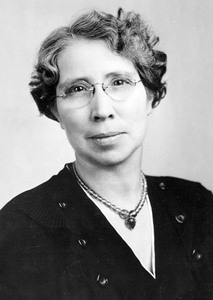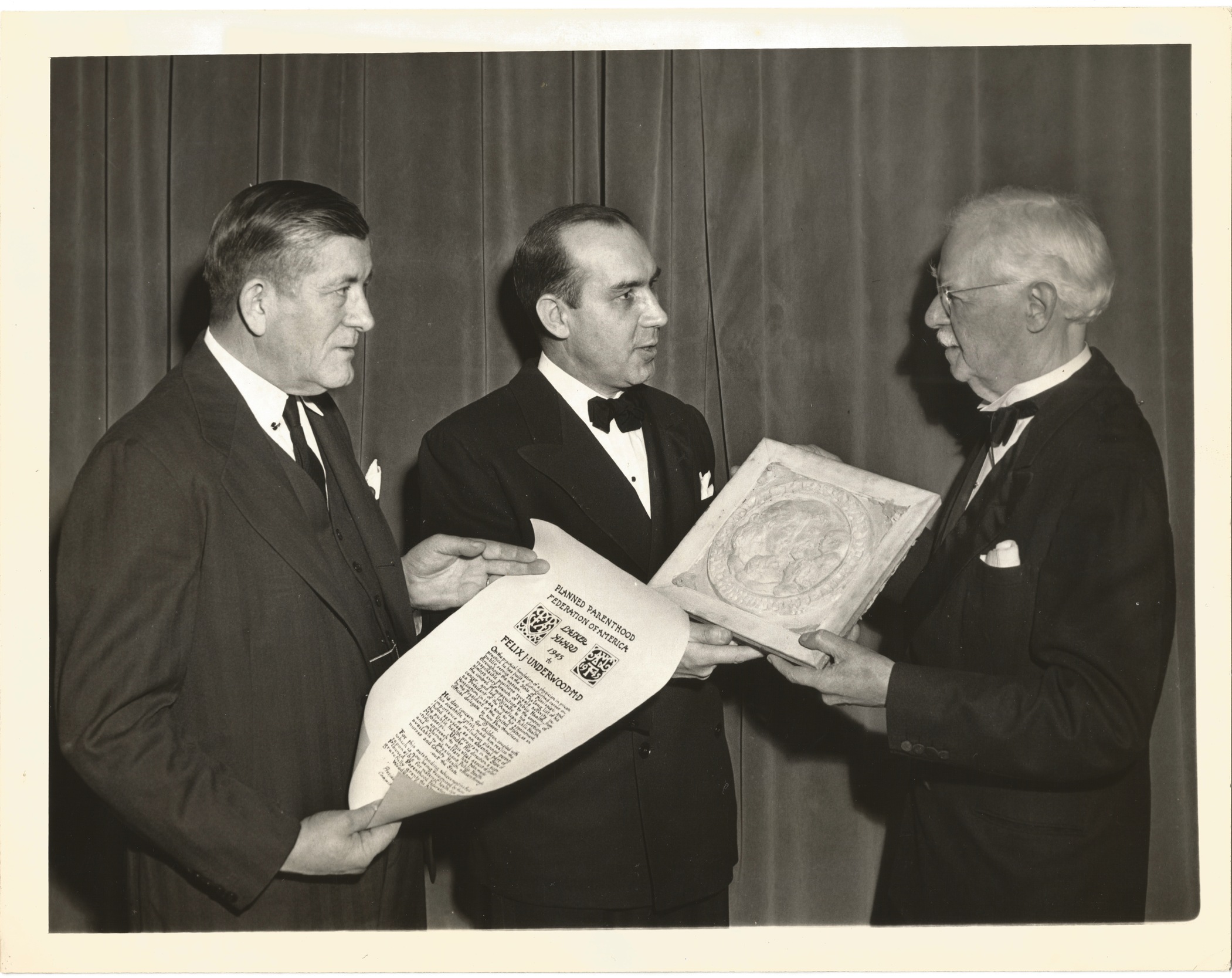The first image shows Dr. Felix J. Underwood, Mississippi’s State Health Officer from 1924-1958, and John McLeod, Ph.D. (1905-1984), Scottish scientist and professor of anatomy at Cornell University, accepting on January 24, 1945, the Albert and Mary Lasker Award. In the course of his career, Underwood received two of the prestigious Lasker Awards,[1] the only physician to date to be thus honored. The Lasker Award, considered medicine’s near equivalent of the Nobel Prize, was just being established by Albert and Mary Lasker when Underwood received his first award. His was one of the very first Lasker Awards given by Planned Parenthood for World Population achievements. Mary Lasker, who founded the Lasker Foundation in 1942 with her husband Albert to promote medical research, had also served as president of the Birth Control Federation of America, the precursor of the Planned Parenthood Federation. In the photograph, Underwood is standing to the left, holding a scroll; to his right is John McLeod, receiving a plaque from Dr. J. H. Upham, Dean Emeritus of Ohio University Medical Association. The men are pictured at the Waldorf Astoria Hotel, which hosted the 24th Annual Meeting of the Planned Parenthood Federation of America. Underwood and McLeod were honored for their efforts in “making childbirth more healthful, safe and secure for American mothers.” The presentations were made at the dinner meeting by Dr. Richard Pierson, a New York obstetrician who chaired the Federation’s Medical Committee. In praising McLeod, who is remembered as his generation’s authority on the human sperm cell and the reproductive physiology of males, Pierson stated the award was in appreciation for “his years of basic research on the physiology of human fertility.” Pierson recognized Underwood’s efforts in expanding the Mississippi health program to include “Planned Parenthood services as an integral part of the public health program of the state of Mississippi.” Both men received a scroll, an artistic plaque, and $500 cash.[2]
Underwood’s scroll bears these words: “On the practical foundation of physician in private practice he has built a distinguished career in public service in the State of Mississippi and throughout the nation. The long list of his responsible positions reveals his activity in almost every branch of Public Health, and led, logically to his election as president of the American Public Health Association in 1944, and to his appointment by the President of the United States, as an official delegate to two Pan American Congresses. His deep concern for children, coupled with his scientific spirit, made him realize the importance of including planned parenthood services as an integral part of the public health program in the state of Mississippi. Under his direction a scientific approach to this vital aspect of infant and maternal welfare has been made available to physicians, Public Health nurses and County Health officers throughout the state. For this outstanding achievement in a field which is now being recognized by those responsible for maternal health care, the Planned Parenthood Federation gratefully grants the Albert and Mary Lasker Award for 1945.”[3]
As Executive Director between 1924 and 1958, Underwood worked ceaselessly to improve hygienic practices and education of midwives. In 1918, 88% of Black women in Mississippi used midwives, resulting in significant mortality and morbidity. Underwood had largely created the state’s maternal and child health programs in the 1920s, and by the early 1930s, he was exploring the necessity of planned parenthood services for the state. A relationship with Margaret Sanger began in the 1930s, and his correspondence with the Birth Control Federation and Planned Parenthood began in 1938 and continued until 1946. Underwood keenly understood Mississippi’s conservative political environment, and despite his commitment to the need for such concepts as parental sex education and child spacing, he waited a decade for the public mood to become more receptive before he asked the Attorney General for an opinion on the legality of such services. Wartime was also a positive distraction for his initiative. In keeping with his pattern of leadership in dealing with potentially controversial issues, Underwood early in the process garnered the support of the medical community, specifically the MSMA’s Maternal and Child Health Committee, which announced at its annual meeting in May 1943 the following statement of support: “That a well-planned, statewide pregnancy spacing and fertility program be started; That when there is need for such services, sound and approved advice, and procedures concerning contraception be included by physicians throughout the State as a part of their services to married couples coming under their care.”[4]
The agency’s child spacing program was launched by Eva Francette Dodge, MD (1896-1990), who was “lent” to Mississippi by the Planned Parenthood Federation of New York. Dodge, portrayed in the second image, was a skilled obstetrician who had expertise in public health and family health work. A New Hampshire native and a pioneer in introducing better maternal care in public health clinics, she focused on child spacing, birth control, and sex education. Dodge strongly believed that birth control was a right of women and that sex education was to be provided for all youth. Dodge began her preparatory work in September 1943, assisted by Katherine Le Van, RN, who was a field worker for Planned Parenthood in New York. After the agency received a supportive AG opinion on January 28, 1944 (Opinion No. 103), Underwood pushed forward with the Planned Parenthood Program, which focused on Dodge creating a child spacing program as an essential part of the work of the county health departments. From January to June 1944, Dodge resided in Mississippi, visiting counties, holding demonstration clinics, and teaching the techniques of contraception to health officers. Local private practitioners were also invited to attend, and two special clinics were held for Black physicians. Jones County was the first county to begin this service. During this period, Dr. Dodge visited 40 counties, made 77 visits to counties, attended 10 maternity conferences, and had 75 consultations. After her work in Mississippi, Dodge would remain in the South, moving to Little Rock to begin a lengthy teaching career as an OB/GYN professor at the University of Arkansas Medical School.[5]
Underwood would later obtain the services of other obstetric consultants to lead the program after Dodge completed her work, including Dr. H. Charles Franklin of the University of Tennessee College of Medicine and Dr. James H. Ferguson of Tulane University School of Medicine. The program eventually expanded to 60 counties in the state and received extensive national recognition as an example of success for other health agencies to follow. Dr. Charles-Edward Amory Winslow, who founded the Department of Public Health at Yale and is recognized as a seminal figure in world public health, stated, “The importance of the Planned Parenthood Program in the public health field has nowhere been better demonstrated than in Mississippi.” [6](p87) Underwood’s efforts to maximize maternal and child health with this program and others appear to have been very successful. Infant, maternal, and neonatal death rates in Mississippi showed impressive declines during the ten-year period, 1938-1947. The infant death rate in 1938 was 56.8 per thousand live births, whereas in 1947 the rate descended to 36.6. The maternal death rate was reduced during the same period from 6.2 per thousand live births to 2.6, while neonatal deaths declined from 31.4 to 24.1. [7](p30)
The origins of Planned Parenthood date to 1916 when Margaret Sanger and others established the first birth control clinic in the United States in Brooklyn, New York. By 1921, she organized the American Birth Control League, which transitioned to the Birth Control Federation of America in 1939. By 1942, the name was changed to the Planned Parenthood Federation of America. Although many associate Planned Parenthood with abortion advocacy, the original mission was quite different. At the awards dinner that January night in 1945, Dr. Abraham Stone, the medical director of the Margaret Sanger Research Foundation, said Planned Parenthood services must have a dual purpose of making available scientific birth control information and overcoming lack of fertility in childless couples.[8]
Maternal and infant mortality remain critical issues for our state and nation. A new CDC report asserts that “more than 80% of pregnancy-related deaths” are preventable, according to 2017-2019 data from Maternal Mortality Review Committees.[9] Mississippi’s infant mortality rate remains the highest in the nation at 8.8 deaths per 1000 live births compared to 6 deaths per 1,000 live births for the U. S., according to the Center for Mississippi Health Policy. Underwood’s current successor as State Health Officer, Dr. Dan Edney, is adopting the mantra “Change Can’t Wait,” focusing his agency on the mission of moving the state off the bottom of health care statistics, especially regarding infant and maternal mortality.
Underwood later received a second “Lasker” Award: the 1953 Albert Lasker Public Service Award, which I will explore further in a future “Images in Mississippi Medicine” essay. For more information on Underwood, see my essay at http://mississippiencyclopedia.org/entries/felix-underwood/. Also, if you have an old or even somewhat recent photograph which would be of interest to Mississippi physicians, please send it to me at drluciuslampton@gmail.com or by snail mail to the Journal. — Lucius M. “Luke” Lampton, MD; JMSMA Editor
Dr. Felix Joel Underwood received the 1945 Lasker Award as well as the 1953 Lasker Award for Public Service, see https://laskerfoundation.org/all-awards-winners/.
Get awards for parent programs. The Knoxville News-Sentinel. January 26, 1945:10.
Dr. Felix Joel Underwood received the 1945 Lasker Award as well as the 1953 Lasker Award for Public Service, see https://laskerfoundation.org/all-awards-winners/.
Underwood FJ, Whitfield, RN. History of Public Health and Medical Licensure in the State of Mississippi, 1938-1947. Vol. II. Jackson, MS: Mississippi State Board of Health; 1951: 85-87.
For more information on Dr. Eva Dodge, see her biographical entry https://encyclopediaofarkansas.net/entries/eva-francette-dodge-1631/.
Underwood FJ, Whitfield, RN. History of Public Health and Medical Licensure in the State of Mississippi, 1938-1947. Vol. II. Jackson, MS: Mississippi State Board of Health; 1951: 85-87.
Underwood FJ, Whitfield, RN. History of Public Health and Medical Licensure in the State of Mississippi, 1938-1947. Vol. II. Jackson, MS: Mississippi State Board of Health; 1951: 85-87.
Get awards for parent programs. The Knoxville News-Sentinel. January 26, 1945:10.
Trost SL, Beauregard J, Njie F, et al. Pregnancy-Related Deaths: Data from Maternal Mortality Review Committees in 36 US States, 2017-2019. Atlanta, GA: Centers for Disease Control and Prevention, US Department of Health and Human Services; 2022.




